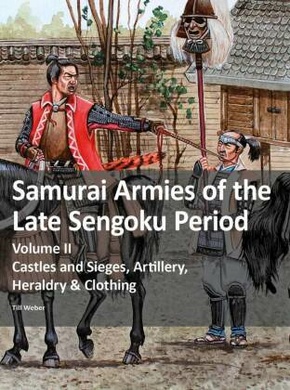
Samurai Armies of the Late Sengoku Period - Volume II: Castles and Sieges, Artillery, Heraldry & Clothing
| Verlag | Zeughaus / Berliner Zinnfiguren |
| Auflage | 2022 |
| Seiten | 112 |
| Format | 20,1 x 0,8 x 27,3 cm |
| Großformatiges Paperback. Klappenbroschur | |
| Gewicht | 555 g |
| Artikeltyp | Englisches Buch |
| ISBN-10 | 396360042X |
| EAN | 9783963600425 |
| Bestell-Nr | 96360042A |
The elegant, multi-storey main towers of Japanese castles, surrounded by massive fortifications, are widely known as symbols of samurai rule. However, the first of these tenshukaku were built only at the very end of the Sengoku period. Most fortifications were built of wood with eart- hen ramparts and ditches exploiting the natural environment.The second volume of this series details these constructions as well as the fortifications that were affected by major sieges: Fushimi, Tanabe, Otsu and Ueda in 1600, and Osaka in 1614/15. The author explains the sophisticated siege techniques and countermeasures employed by samurai armies of the period, and the Japanese artillery of the time.A second focus is on the complex heraldry of leading as well as lesser known samurai families of the Sengoku period, illustrated by many colourful examples.The third part offers an introduction to the world of traditional Japa- nese textile patterns and colours, their use, methods of manufacture in the pre-industrial age, and their special symbolism in the context of samurai history.
Inhaltsverzeichnis:
Castles, Forts and FortificationsAn Eye Witness ReportFortifications Built of Wood and EarthYamashiroCastles Built of Stone, Wood and EarthElements of Japanese Fortification ArchitectureSieges, Siege Equipment and ArtillerySieges: Four Case Studies from the Year 1600Siege Technology and EnginesSamurai and ArtilleryHeraldry, Banners, and Battle Standards - Forms & FunctionsKamon, the Japanese Coat of ArmsLarge Rectangular Banners - Nobori no hataBack Flags - SashimonoOther Forms and Functions of FlagsMaritime HeraldryHeraldic and Other Military Unit DistinctionsSamurai Clothing, Colours and Textile PatternsDevelopment of Clothing - Kimono and NoragiA Garment fit for a Warrior - the JimbaoriSocial Status, Clothes and Choice of ColoursColour CombinationsTraditional Japanese Clothing Colours and their ApplicationsTextile PatternsBibliography
